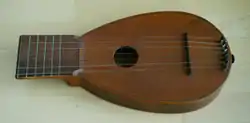Stoessel lute
The Stoessel lute (German: Stössel-Laute) is a string instrument invented by Georg Stössel in 1914 in Cologne (Köln), Germany. Its steel strings are fingered not by putting one's hand round the neck, but over the end of it. To this end, most Stössel lutes have very short necks. It is, in effect, a hybrid between a necked string instrument and a zither. [1]
 | |
| String instrument | |
|---|---|
| Other names | Stössel lute, Stössel-laute |
| Classification | String instrument |
| Hornbostel–Sachs classification | (Composite chordophone) |
The instrument was very popular in Germany and elsewhere in the early 20th century; it was frequently used in German and Austrian schools in the inter-war period. The Second World War put an end to production and the instrument never regained its former popularity.
External links
- The Stössel-lute, Greg Miner, Miner Music
- miscellaneous at ATLAS of Plucked Instruments
- Zither & Harp at SpringerMusic.co.uk
This article is issued from Wikipedia. The text is licensed under Creative Commons - Attribution - Sharealike. Additional terms may apply for the media files.